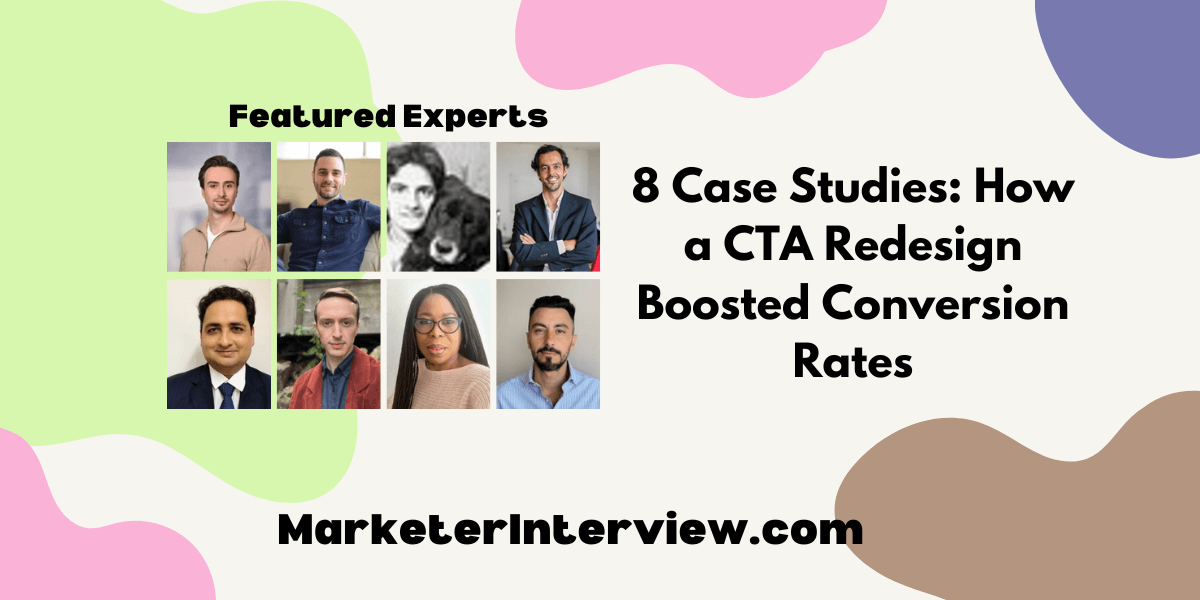8 Case Studies: How a CTA Redesign Boosted Conversion Rates
In the quest to unlock the secrets of effective call-to-action strategies, we’ve compiled insights from eight industry experts, including Copywriters and CEOs. They share their experiences, from optimizing CTA copy for relevance to personalizing and simplifying CTAs for more clicks, demonstrating the power of well-crafted prompts in driving conversion rates.
Want to get quoted in MarketerInterview.com content just like this? Apply to become a contributor today!
Contents
Optimize CTA Copy for Relevance
Crafting the right CTA while maintaining accessibility guidelines is a challenge for the modern UX copywriter. Instead of “learn more” or “see more details,” I try to make the CTA relate as much as possible to the content. For example, on the landing page for a client’s nutrition course, I changed the button copy to “Get more bite-sized info.” To date, it has been the highest-clicked CTA on the page. It’s encouraging, it’s fun, and it’s relevant to the product.

Ben La Bouve, Copywriter and Content Strategist
Comprehensive A/B Testing Case Study
Case Study: E-Commerce Clothing Retailer
Background:
An e-commerce site specializing in boutique clothing noticed that their main product page was generating traffic but not conversions commensurate with this traffic. The primary CTA on this page was “Shop Now”.
Challenge:
The CTA was underperforming, leading to lower-than-expected sales despite high traffic. The company hypothesized that the CTA was not effectively engaging potential customers or clearly communicating what action to take.
Intervention:
The web design team decided to test variations of the CTA to determine if changes in design or copy could improve conversion rates. They implemented an A/B testing strategy with the following modifications:
1. Copy Variation:
– Original: “Shop Now”
– Variant: “See What’s New Today!”
2. Design Variation:
– Original: A simple blue button with plain text.
– Variant: A larger, orange button with a subtle shadow effect to make it ‘pop’ on the page.
Execution:
The team ran the A/B test for one month, directing 50% of traffic to the original CTA and 50% to the variant versions. They monitored conversion rates, defined as the percentage of clicks on the CTA that led to a purchase.
Results:
– The copy variant “See What’s New Today!” resulted in a 20% increase in click-through rate compared to the original “Shop Now”. This indicated that a more engaging and context-specific CTA copy resonated better with visitors.
– The design variant with the orange button saw an 18% increase in conversions over the original blue button. The more visually striking button stood out more on the page, drawing more clicks.
Conclusion:
This test confirmed that both copy and design modifications could positively impact CTA performance. By making the CTA more visually appealing and contextually relevant, the retailer significantly boosted its conversion rate. This case study exemplifies how understanding user engagement and motivation can lead to better design decisions that directly affect business outcomes.
Takeaway
In web design, especially e-commerce, the power of CTA optimization cannot be underestimated. Small changes, informed by user behavior and preferences, can lead to substantial improvements in conversion rates. This approach underscores the need for continuous testing and refinement to stay aligned with user expectations and market trends.

Hardik Parikh, Principal Consultant, Software Hub Blogger
Enhance Urgency in CTA for Sales Boost
A specific instance that underscores the power of well-optimized call-to-action (CTA) design and copy involved a European e-commerce client at CodeDesign. They were facing plateauing sales despite steady website traffic, which indicated a potential inefficiency in their CTA strategy. We re-evaluated their main product page and implemented a more compelling CTA that shifted from a generic “Buy Now” to “Get Yours While Stocks Last!” accompanied by a more vibrant color contrast in the button design.
This minor change significantly enhanced the urgency and visibility of the CTA. Within the first month after implementation, the client observed a remarkable 35% increase in their conversion rates. This example perfectly illustrates how even subtle shifts in CTA design and wording can tap into consumer psychology, encouraging more decisive action that directly translates to increased sales. It’s a clear demonstration of why paying attention to every detail of user engagement is crucial in digital marketing.

Bruno Gavino, Founder and CEO, CodeDesign
Revamp Newsletter CTA for Higher Sign-Ups
We faced a challenge with DogWithBlog.in, where the newsletter sign-ups were not growing. We redesigned the sign-up pop-up on the homepage, optimized the visual appeal, and crafted compelling copy to entice visitors to subscribe. For our adoption camp, we revamped the design by adding an eye-catching illustration of an adorable dog and rewriting the copy to emphasize adoption updates on the go.
Within just two weeks of implementing these changes, we witnessed an impressive 40% increase in our adoption newsletter sign-ups, demonstrating the significant impact of design and copy optimization on conversion rates. This success underscored the importance of understanding the target audience and crafting CTAs that resonate with their interests and motivations.

Abhishek Joshi, Digital Marketer, Dog with Blog
Articulate Value in CTA for Engagement
One memorable instance occurred while working with a client at Spectup who was struggling with low engagement rates on a promotional campaign aimed at software trials. The original call-to-action (CTA) was simply “Try Now,” which was not performing as expected.
We decided to revamp the CTA based on two strategic changes: optimizing the design and modifying the copy. The original CTA button blended too seamlessly with the page’s design, lacking the visual pop needed to grab attention. We changed the button color to a bright blue, which contrasted sharply against the website’s primarily gray palette, making it immediately more noticeable.
For the copy, we shifted from the generic “Try Now” to a more benefit-focused phrase: “Start Saving Time Today.” This new wording clearly articulated the value proposition, suggesting a direct benefit to the user rather than merely suggesting a trial.
The results of these changes were striking. The click-through rate for the CTA increased by over 30%, and the overall conversion rates for signing up for the software trial rose significantly. This success highlighted how even minor adjustments in CTA design and wording can profoundly impact user engagement and business outcomes.

Niclas Schlopsna, Managing Consultant and CEO, spectup
Test Earlier Buying Journey CTA
Oftentimes, lowering the expected amount of work that a lead has to go through can lead to increased conversion rates.
For example, I’m working with a client whose call-to-action was initially “Get a Quote,” which is very far in the user journey, and as a user, you know you’re going to be connected with a salesperson. Not everyone is ready for that in the exploratory or research stages.
We changed the call-to-action to test “Get a Preview” (of the service we were promoting) and saw a much higher conversion rate.
This allowed us to capture user information for nurture and follow-up, and also allowed us to give the user more exposure to our service through a more robust preview.
Key takeaway: Try shifting your call-to-action to slightly earlier in the buying journey to test its effect on conversion rates.

Ryan Morgan, Digital Marketing Strategist, swell Digital
Shift to User-Centric CTA Copy
I once observed a significant uplift in conversion rates by simply changing the copy of a call-to-action (CTA) on a homepage. Originally, the CTA invited users to “Book a Demo,” but shifting it to “Get Started” more than doubled the conversion rate.
This change suggested a more immediate and less committal interaction, which resonated better with users. It highlighted a shift from a sales-driven approach to a more user-centric one, effectively engaging visitors by aligning with their readiness to take action without feeling pressured.

Marco Genaro Palma, Freelance CMO and SEO Consultant, SEO Coach
Personalize and Simplify for Clicks
We run many CTA tests, but there’s not one specific one to point out. In most cases, it works best to keep it short, simple, personalized, and use an outstanding color for the design.
This has resulted in a remarkable 75% increase in clicks on the call-to-action. This example underscores the power of personalization and the impact of seemingly minor tweaks in CTA design or copy on conversion rates.

Inemesit Ukpanah, Digital PR Specialist, GreenMatch
Want to get quoted in MarketerInterview.com content just like this? Apply to become a contributor today!






